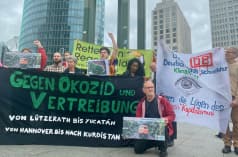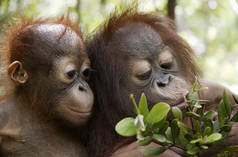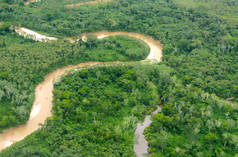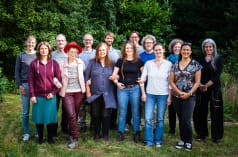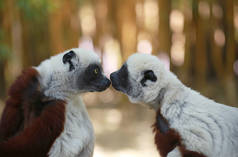A better way to protect biodiversity: strengthening indigenous rights!
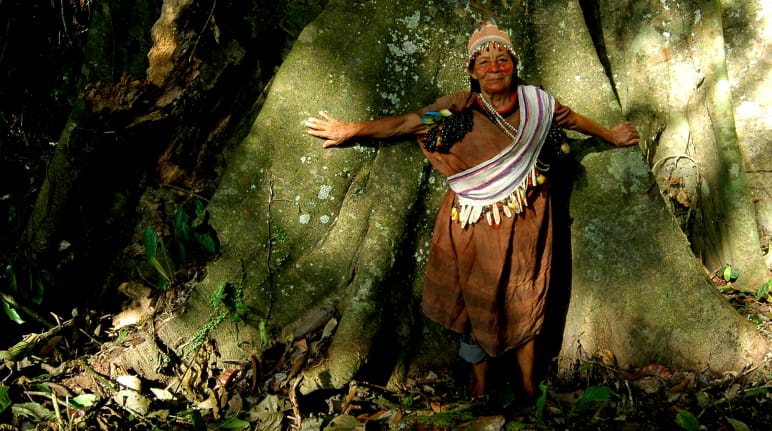 © Nathalie Weemaels
© Nathalie Weemaels
One million animal and plant species could become extinct if we don’t act to protect biodiversity. In December 2022, the UN Conference on Biological Diversity will therefore rule that 30 percent of the planet’s surface should be protected worldwide by 2030 – a problematic plan.
News and updates Call to actionTo: the CBD Secretariat, CBD Member States and German Chancellor Olaf Scholz
“Putting more land under protection is not the answer to the extinction crisis. We need effective solutions like strengthening the rights of indigenous people.”
Protected areas can play an important role in preserving biodiversity and climate, but they are not a panacea.
Respecting the rights, knowledge and way of life of indigenous peoples and other local communities are often more effective. Studies show that nature is in better condition where they are in charge and have land rights.
Plans like “30 percent by 2030” set off alarm bells among environmentalists and human rights activists: Up to 300 million people could suffer if the land where they have often lived in harmony with nature for many generations were suddenly to be “protected”.
Protected areas such as national parks often follow the concept of “fortress nature conservation,” which calls for the strict separation of humans and nature – enforced by rangers who are often armed to the teeth. Human rights violations and even killings have been reported from numerous protected areas.
“This future land grab must be stopped,” says Ladislas Désiré Ndembet of the Cameroonian NGO Synaparcam.
Can more protected areas save biodiversity? It’s doubtful. For despite the vast number of such areas, the climate and biodiversity crises have intensified.
Rather than setting arbitrary goals like protecting 30 percent of the planet's surface, it makes more sense to improve the protection of biodiversity in areas where it is the greatest. These include the rainforests.
It is also imperative that we overcome our present way of doing business and living, which is based on excessive consumption of raw materials, agricultural products and energy.
In the face of the extinction crisis, we need effective solutions instead of inadequate concepts. Please call on the international community to strengthen the rights of indigenous peoples.
BackgroundWhat types of protected areas are there?
Worldwide, there are numerous types and categories of protected areas. They differ mainly in terms of what is considered worthy of protection, who is responsible, what is permitted and what is prohibited. Here is a global overview.
In Germany, the spectrum ranges from bird sanctuaries and landscape protection areas to national parks and biosphere reserves. The designation Natura 2000 is common in the EU.
At the international level, the World Heritage Sites and Man and the Biosphere Reserves of the UNESCO and the Ramsar wetlands of international importance play a prominent role. The International Union for Conservation of Nature (IUCN) puts protected areas into six categories.
The Convention on Biological Diversity (CBD) refers to “protected areas” and “other effective area-based conservation measures”.
Why is the topic of protected areas so controversial right now?
A major driver of the current intense debate is the plan by the UN and many countries to place 30 percent of the Earth’s surface under nature conservation. The WWF and some scientists are even calling for 50 percent to be protected.
For the UN Biodiversity Conference in Montréal, Canada, in December 2022, the Convention on Biological Diversity (CBD) is propagating the “30 by 30” target. According to this, 30 percent of the Earth’s surface and oceans are to be placed under nature conservation by 2030.
This “Kunming-Montreal Global Biodiversity Framework” will shape international nature conservation policy for decades, well beyond 2030. Bad decisions will be difficult to correct.
How was the 30 percent target established?
As early as 2011, the international community had set itself a target: by 2011, at least 17 percent of land area and inland waters and 10 percent of the coasts and seas should be placed under nature protection. However, none of these Aichi targets were fully achieved. The same goes for the Sustainable Development Goals (SDGs).
We can safely assume that the figure of 30 percent is a marketing tool. “30 by 30” is more memorable than, say, “25 by 2030” or “40 by 2025”. In any case, there is no scientific basis for the figure. In June 2022, a study in the journal Science put the protection target at 44 percent of Earth’s terrestrial area – a space that is also home to 1.8 billion people. Popular biologist and author Edward O. Wilson stated the goal of “half of the Earth” – with its implication of humans sharing the planet fairly with nature.
However, according to a 2020 study, it would be enough to increase protected areas by 2.3 percent to protect almost all rare and threatened species. It is noteworthy that the authors of the study nevertheless support the 30 percent target.
Does a percentage even make sense?
That’s debatable. One could, for example, reach 30 percent by protecting the Sahara and northern Canada and Siberia – but that would do little for biodiversity. Admittedly, few people live there, and social conflicts would be comparatively easy to avoid.
If the 30 percent target is to make a difference, regions with a high level of biodiversity must be put under protection – but hundreds of millions of people live there who could potentially be deprived of their rights. In addition, the highest biodiversity is often found on the traditional lands of indigenous peoples and other marginalized population groups. Their livelihoods and cultures are therefore in particular danger.
On the other hand, the 30 percent figure could already be achieved today if indigenous territories were protected. For this to happen, the UN and other organizations would have to recognize that the indigenous way of life can make a crucial contribution to nature conservation.
What does “30 to 30” fit with global justice?
In a nutshell: countries in the global North became rich because they had no qualms about exploiting nature. They are thus responsible for the biodiversity and climate crises. Now, large swathes of the planet are to be placed under protection so that these crises do not worsen. Since unspoilt nature and the greatest biodiversity are still to be found in poorer tropical countries, they will bear the greatest burden when placing areas under strict protection instead of using the resources available to them. Thus the poor are being asked to make sacrifices, while the rich hardly limit their resource consumption.
Who stands to suffer from protected areas and goals like “30 by 30”?
We fear that indigenous and local communities will be among the losers. Up to 300 million people could suffer if the land where they have often lived in harmony with nature for many generations were suddenly to be “protected”. (At 50 percent, more than a billion people would be impacted.)
The environmental site Mongabay writes that the “30 by 30” goal has become a “conservation battleground”.
In short: “30 by 30” pursues a neo-colonial, militarized “fortress conservation” approach that is not inclusive of the local and mostly indigenous population, but rather oppresses them, marginalizes them further and violates their rights.Experiences from protected areas, especially in Africa and Asia, give cause for concern. In the Congo Basin, for example, the establishment of 34 protected areas led to 26 cases of local communities being displaced without compensation.
In Tanzania, the indigenous Maasai people are suffering from displacement and violence because the government wants to expand the Ngorongoro Conservation Area (NCA) to promote tourism. Rainforest Rescue is campaigning to protect the rights of the Maasai with a petition.
“30 by 30” is based on a Western attitude toward nature and conservation and ignores indigenous understanding of the world and knowledge.
Who benefits from this?
Establishing and managing protected areas and “other effective area-based conservation measures” can be a lucrative business model for companies and major environmental organizations. Critics see it as a new source of finance for the “conservation industry”.
“Other effective area-based conservation measures” include carbon offsetting and “nature-based solutions” such as the wholesale planting of trees, a measure also advocated for climate protection.
Protected areas such as national parks are already being managed as public-private partnerships (PPP): In this process, states hand over their responsibility, but also their control, to companies or non-governmental organizations:
Founded by Dutch billionaire Paul Fentener van Vlissingen, the organization African Parks is managing 22 national parks in 12 African countries in 2022, covering an area of more than 20 million hectares. (To put that in context, the United Kingdom has an area of 24.3 million hectares.) The organization aims to increase the number of parks it manages to 30 by 2030. According to the company’s website, it is pursuing “a clear business approach to conserving Africa’s wildlife and remaining wild areas”. The president of the organization is the English Prince Harry, Duke of Sussex.
What other measures is the CBD pursuing?
The draft of the Post-2020 Global Biodiversity Framework mentions, among other things, protected areas, “nature-based solutions” against climate change, wildlife trade, environmental pollution such as plastic, the “rights of nature” and an end to environmentally harmful government subsidies.
Its vision is “living in harmony with nature” by 2050. This will requires a transformation of economic, social and financial systems.
While the draft mentions the rights of indigenous peoples and local communities, traditional knowledge, and the rights of women and girls, NGOs fear that they will be neglected.
Against the backdrop of the Covid pandemic, the recognition that pandemics and environmental degradation are linked is likely to inform negotiations, for example under the rubric of One Health.
One sticking point is funding. The rich countries, which are to blame for much of the extinction crisis, have a responsibility to provide billions of dollars. However, it is questionable whether they will do so. As we have seen with climate protection, even pledges that are too small for effective measures are not being fulfilled.
What is clear is that the targets set for 2020 have been missed by a wide margin. The starting point of the negotiations for the period up to 2030 is therefore a failure. Some member states even question the point of tighter targets due to the lack of implementation and funding of the previous goals.
Why is biodiversity threatened?
The rate of extinction we are currently witnessing last occurred 66 million years ago, when the dinosaurs disappeared. This sixth mass extinction in the history of our planet was not caused by the impact of an asteroid, but by us. Humans are altering and destroying plant and animal habitats, hunting, poaching, polluting the environment with toxins, and are ruining the climate in such a way that many species cannot adapt.
You can find out more about this on our biodiversity background pages.
How important is UN Conference on Biological Diversity, COP 15?
Extremely so!
We humans are causing mass extinction of species, and we can intervene and prevent worse from happening. To do this, we need to take drastic measures quickly. The UN Conference on Biological Diversity COP 15 will set the course for how species conservation will be organized in the coming decades.
Formally, China is hosting COP 15, due to the Covid pandemic it is taking place in Canada where the CBD is headquartered.
To: the CBD Secretariat, CBD Member States and German Chancellor Olaf Scholz
Ladies and Gentlemen,
Dear Mr. Chancellor,
The collapse of biodiversity is one of the existential crises of our time, along with the climate crisis. They demand profound reforms and bold action from our society.
Protected areas and “other effective area-based conservation measures” (OECMs) play a significant role in conserving biodiversity and ecosystems but are subject to significant risks. The Post-2020 Global Biodiversity Framework’s goal of placing 30 percent of the world’s land are under protection by 2030 poses several threats.
- Many protected areas and OECMs are associated with violence, impoverishment and displacement, especially of population groups who have lived there in harmony with nature for generations. The price of nature conservation is then the violation of human rights. “30 by 30” has the potential to be the biggest land grab in history.
- Many protected areas and OECMs do little to conserve nature; their establishment only serves as an alibi and distracts from effective measures.
- Targets such as 30 or even 50 percent are obviously based on political considerations rather than scientific facts.
- The establishment and management of protected areas and OECMs promises profit to large, often Western organizations and companies, and helps the latter to continue their climate-damaging business model via “nature-based solutions” that occupy land.
- The management of protected areas and OECMs often does not take regional and local specifics into account.
At the same time, there is growing recognition, backed by science, that nature is best preserved where indigenous peoples and local communities live and where their rights are protected.
We therefore call on you to:
- Strengthen the rights of indigenous peoples and local communities. This involves the guarantee of forest and land rights, the right to free, prior and informed consent, protection against violence and displacement, and equitable participation in economic and social development.
- Strengthen the role of indigenous peoples and local communities in national and international negotiations and in the implementation or monitoring of decisions taken. Traditional indigenous knowledge must be incorporated.
- Work to ensure that indigenous peoples and local communities are better funded so that they can truly fulfill their role as stewards of nature.
- Work to combat the root causes of the biodiversity crisis, in particular resource exploitation and overconsumption.
Yours faithfully,
Petition delivered to UN – “A better way to protect biodiversity”

We delivered a clear message, and it was heard by the UN: the Executive Secretary of the Convention on Biological Diversity, Elizabeth Maruma Mrema, had an open ear for our arguments and pledged to highlight the dangers of narrowly focusing on protected areas alone during the negotiations.
COP 15: Can the UN stop the extinction crisis?
Can we stop the mass extinction of animal and plant species? Nothing less is at stake at the UN Biodiversity Conference from December 7 to 19 in Montréal. The scale of the crisis is alarming – up to one million species could be wiped out within the coming decades. We will be meeting with the Executive Secretary of the Convention on Biological Diversity, Elizabeth Maruma Mrema, in Montréal.
As a conservation organization, is Rainforest Rescue against protected areas?
No, we are not against protected areas per se.
Many play an important role in preserving biodiversity and protecting the climate. We frequently speak out when protected areas are threatened, for example when logging or oil exploration concessions are granted in such areas. We also generally oppose the downsizing of such reserves.
However, protected areas are not a panacea: establishing them entails risks and can even lead to effective measures being neglected. Designating protected areas is appealingly simple, while fundamental changes to our consumerist lifestyle are unpopular and more difficult to achieve.
Studies show that nature is in better condition where indigenous peoples and local communities are in charge and have land rights.
According to the 2021 Territories of Life Report, if the land they manage were added to the official protected areas (17 percent of the Earth), 31 percent of the Earth would already be under protection.
In other words, if all indigenous lands – which are home to 80 percent of global biodiversity – were recognized and secured, the 30 percent target would be met. This underscores that indigenous rights and the protection of biodiversity are closely linked.
Ladislas Désiré Ndembet of the Cameroonian NGO Synaparcam
Ladislas Désiré Ndembet of the organization Synaparcam:
30% of the territory to be conserved is too much for our poor or developing countries like those in Africa or Gabon where I come from. This project will reinforce the bad governance that we already suffer. It will increase corruption and poverty because the phenomenon of land grabbing will be greater.
In 2002, Gabon dedicated 11% of its territory with the creation of 13 national parks. Numerous promises were made to indigenous populations and local communities in terms of development, including ecotourism. To date, none of this has happened. The riparian communities continue to suffer in misery and poverty. This percentage has been steadily increasing with the international demands and promises of carbon offsets.
Since 2012, land has been made available to agribusinesses and other carbon credit investors. No, this cannot continue. This future land grab must be stopped. In our country where the rural domain is not defined at all, such a project will literally push the indigenous populations and local communities into absolute precariousness.
All I can say to this macabre project that it is absolutely necessary to fight.
where it is the greatestWhereby every species must be saved from extinction, regardless of the location.
international communityThe “international community” in this case encompasses the member states of the Convention on Biological Diversity (CBD). The CBD is based in Montréal, Canada.
According to the 2021 Territories of Life Report, if the land they manage were added to the official protected areas (17 percent of the Earth), 31 percent of the Earth would already be under protection.
In other words, if all indigenous lands – which are home to 80 percent of global biodiversity – were recognized and secured, the 30 percent target would be met. This underscores that indigenous rights and the protection of biodiversity are closely linked.
This petition is also available in the following languages:
Help us reach 100,000:
